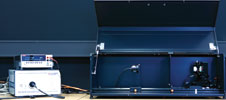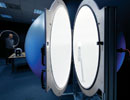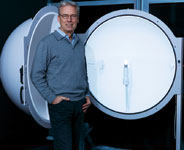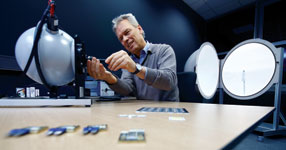
With its LightLab, EBV Elektronik is offering customers throughout the EMEA region access to a professional light laboratory.
Even newcomers to the field of LED lighting can use the facility to perform almost all the relevant photometric measurements from single LEDs and LED modules to complete lamp systems.
Many light manufacturers would like to make the leap from conventional filament and CFL lamps (energy-saving bulbs) to LED lighting, but currently have neither the necessary design expertise nor the expensive measuring equipment. For many years now, EBV has been providing these customers with expert support as part of its LightSpeed activities.
Since February 2012, the distributor has been offering its customers the new LightLab service at its site in Poing, near Munich.
This makes it the first European distributor to enable its customers in the EMEA region to perform radiometric and photometric measurements across the entire light chain: from measurements on individual LEDs or LED modules and comparative measurements of light sources (eg, light bulbs versus CFL or LED solutions) right up to the complete measurement of entire lights up to a certain size.
This service gives even small companies access to high-precision measuring technology – and always with assistance from an EBV LightSpeed expert.
EBV will also hold training and customer seminars in the new LightLab. In these training seminars, the company will discuss the differences, advantages and disadvantages of the various light sources and give tips on optimum implementation of lights adapted to the relevant application.
The EBV LightLab will also be used for training the company’s own FAE team. In the medium term, EBV also intends to develop dedicated reference designs for LED lighting.
“The EBV LightLab is a further milestone in the field of individual customer support. We are very proud to be the first company in the European semiconductor distribution industry to offer customers from the whole EMEA region access to an ultra-modern light laboratory featuring state-of-the-art equipment,” emphasises Wolfgang Reis, EBV LightLab manager.
“The EBV LightLab allows customers to calculate and evaluate their lighting projects even more quickly and efficiently, thereby considerably shortening their time to market,” he continues. “A further key element in the EBV LightLab is the EBV LightAcademy.
“In addition to on-site training in the EBV LightLab, the EBV LightAcademy will also offer online training, thereby allowing all our EMEA customers to take part in these seminars live in the form of webinars.”
Reference-class measurement devices
When selecting the equipment for the LightLab, EBV made investments in the six-figure Euro region and quite deliberately opted for an entire range of highly professional devices, most of which are manufactured in Germany.
The list of the measuring devices includes two integrating spheres for two and four measurements, a spectroradiometer for reference measurements, a goniophotometer, a light density measuring device and a luxmeter. This product range is complemented by special measurement/evaluation and control software, source meters and multimeters, a thermal camera and supplementary tools.

Integrating spheres with a diameter of 250 mm and 1000 mm
At first glance, the most noticeable element in the LightLab is the two integrating spheres, where the lighting current and the radiant power are measured. These measurements are necessary for determining the luminous efficiency (measured in lumens per Watt).
In addition, it is in these spheres that colorimetric measurements of the quantitative spectral distribution are performed and the colour temperature and colour rendering index are determined.
The LightLab contains two integrating spheres: a 2 sphere with a diameter of 250 mm and a 4 sphere with an internal diameter of 1000 mm. The interior of the integrating spheres is lined with barium sulphate (BaSO4), which diffusely reflects around 98% of the light.
The light is therefore optically integrated in the sphere via the reflective surfaces on its inside, which allows the luminous flux to be measured.
For example, the small integrating sphere is where individual LEDs are measured or selected. The 250 mm integrating sphere allows the engineers to measure the semi-spherical space (steradian: 2) above a small circuit board, and hence an LED.
This means that personnel can for example select, in a 250 mm integrating sphere, LEDs with a precisely defined wavelength if five identical LEDs are needed.
However, an appropriately-sized 4 sphere is required for measuring an entire luminaire. For this reason, EBV has also acquired an integrating sphere with an internal diameter of 1000 mm (steradian: 4) for all-round measurements, in addition to the 250 mm sphere.
This large 4 integrating sphere is also ideal for comparative measurements – for example between filament or halogen bulbs and LED lamps – or for the CIE-compliant measurement of high-power LEDs and entire lights with an edge length of up to 90 cm.
A special holder inside the spheres allows an E27 fixture or light to be attached for this purpose. EBV also provides the right mechanical adapters for measurements in the sphere.

Measurements with a market leader
The two integrating spheres as well as both of the extremely complex measurement devices in the new LightLab were manufactured by the German company, Instrument Systems in Munich, a market leader in the field of LED metrology and works closely with various international commissions.
The devices meet the CIE (International Lighting Commission) requirements for precise measurements of the luminous flux, which is measured in lumens. An excerpt from the list of Instrument Systems’ reference customers reads like a ‘who’s who’ of the industry, containing not only leading LED manufacturers but also renowned users such as Apple, Avago, Everlight, Osram OS, Vishay and Zumtobel.

Spectroradiometer
A core element of all the measuring technology in the EBV LightLab is the CAS 140CT spectroradiometer from Instrument Systems, which is designed to perform industry reference measurements under continuous 24-hour operation.
This high-precision device measures the spectral power distribution of a 1100 nm light source (infrared) within milliseconds through the visible light spectrum into the UV range at 380 nm – with a data point interval of 0,8 nm over a very high intensity measuring range of nine decades, which corresponds to a dynamic range of 1:1 billion.
All of the measured values are output via the USB bus to a PC/laptop/notebook, where the SpecWinPRO software then handles further processing of the data in Windows (XP and higher). Not only does this software deliver the measurement data in the form of individual items of data in a table, it also displays the spectral distribution and position in the colour diagram in graphic form.
In this way, the software also calculates the colour temperature and colour rendering index (CRI) on the basis of the measured values. Here, the device measures ‘only’ the radiometric output; to determine the photometric output, the software evaluates the radiometric spectral measurement data on the basis of the sensitivity curve of the human eye and outputs the luminous flux in lumens.
Using a plug-in, the SpecWinPRO software controls a Keithley source meter. This means that the entire measurement process can be controlled via software – from the electrical activation of the LED to the details of the data output and data processing. The light to be measured reaches the analysis device via CIE-compliant optical probes and a fibre-optic cable.

Practical example
The following example, which describes the development of a light with a total light flux of 500 lm, demonstrates how a high-precision spectroradiometer in a 4 sphere with a diameter of 1000 mm can help engineers in their work.
Theoretically, five single 100-lumen LEDs are sufficient for this design, but the use of diffusers and lenses leads to a certain amount of loss. In the 1000 mm integrating sphere in the EBV LightLab, manufacturers can measure finished systems and identify whether five LEDs are sufficient for ensuring compliance with the specifications or whether a sixth one is needed.
Alternatively, the light can be measured with a modified diffuser-lens system to see whether the specifications can potentially be met with just five LEDs.
Differential measurements with the aid of auxiliary lights in the 4 sphere enable the SpecWin PRO software to partial out any measured value distortions caused by unwanted absorption by the light housing.
In practice, however, this absorption is completely irrelevant because it only affects the semi-spherical space that does not receive any light anyway – in other words, the area behind the lamp.

Colour spectrum and colour reproduction in practice
Light and lamp designers are very interested in the spectral distribution of light. In this context, investigations focus not only on the location of intensity peaks and spectral distribution, but also on the colour reproduction index and colour temperature.
For example, the CRI value describes how an object appears when irradiated with a certain light. A good example of this is the bright street lights which emit a yellowish light from their sodium vapour lamps.
Sodium vapour lamps are very efficient and deliver a high luminous flux (measured in lumen) for the amount of electric power they use, which means that they offer a high luminous efficiency (lm/W).
However, the yellowish light emitted by sodium vapour lamps is relatively mono-spectral. Although under this light you can clearly see whether or not there are any people, animals or vehicles on the road, it is not possible to distinguish green lines from red ones on a map under this type of street lighting. Also, trees appear black.
Similarly, a number of different light-emitting diodes are limited by certain compromises in terms of colour. However, it is now possible to compensate quite effectively for these limitations, and with suitably clever designs it is currently quite possible to generate light with an excellent colour reproduction index well above 90. However, a 4 integrating sphere and a spectroradiometer are required in order to measure this type of light source.
Goniophotometer
With the aid of a goniophotometer of type LEDGON 100 from Instrument Systems, EBV Elektronik is able to determine the angle-dependent directional characteristics of individual LEDs and smaller LED modules, with an angular resolution of 0,1° throughout the entire half-space in the beam direction of the LED.
In combination with the aforementioned CAS 140CT spectroradiometer, this also enables EBV to measure various spectral parameters such as colour coordinates or colour temperature as a function of angle. Since a number of different parameters of white LEDs – such as the colour temperature – vary significantly with the beam angle, these measurements play a very important role.
While geometry-related measurement errors can occur in measurements performed in an integrating sphere, the goniophotometer – which is equipped with servo motors and controlled fully automatically by the SpecWinPRO software – is also ideal for precisely determining the radiant power and luminous flux and, in turn, the all-important luminous efficiency quotient, which is specified in lm/W.
The SpecWinPRO software is again used for the goniophotometer for processing and presenting the measurements, which are then available in the IES and EULUMDAT export formats for further processing. These data formats represent the characteristic beam data for an LED, and they can then be used as the starting data point for the simulation of a complete lamp.
Source meter
The 2440 source meter from Keithley is essentially a high-precision, programmable constant current and constant voltage source for actuating LEDs and LED modules under test conditions in the EBV LightLab. The current and voltage can be precisely set via the serial interface.
To minimise the load on the light sources during measurements, the source meter can be software-controlled so that the LEDs are switched on only during the actual measurement but remain switched off during gaps between measurements. The 2440 source meter is also an ultra-high-precision volt and ampere meter that transfers the current, voltage and power data to the measurement software via an interface.
Additional measuring instruments
The range of measuring equipment in the LightLab also includes an infrared camera. This camera allows ‘hot spots’ on circuit boards to be identified in good time so that thermal management (ie, the proper dissipation of thermal losses) can be optimised on the basis of this data.
In addition to these measuring instruments, the LightLab also features two lighting measurement devices, the Mavo-Spot 2 light density measuring device and the Mavolux 5032B luxmeter.
By focusing on objects such as roads, tunnels, sports grounds or airfields from a distance, the Mavo-Spot 2 ‘light density camera’ enables corresponding light density measurements (in cd/m²) to be performed. It can also be used for determining the light density of displays, monitors or projection screens.
The angle of detection of the Mavo-Spot 2 is just 1°, which allows for a highly precise selection of the measurement points or pixels on which the device focuses. The measurement object can be located anywhere from 34 cm to an infinite distance away from the device.
The Mavolux light meter allows users to calculate the illumination levels (measured in lux) at the workplace and on other surfaces.
EBV’s LightLab also features a range of universal multimeters that measure not only the actual effective values of voltages and currents, but also the effective power values. These devices also enable the measurement of resistances, frequencies and capacitances. Also featured is equipment for measuring and monitoring temperature.
Various pieces of equipment ranging from small tools through miniature drills to special stations for the temperature-controlled soldering of LEDs onto MCPCBs ensure that users themselves can carry out small modifications or repairs directly in the LightLab.
For more information contact EBV Electrolink, +27 (0)21 402 1940, [email protected], www.ebv.com
| Tel: | +27 11 236 1900 |
| Email: | [email protected] |
| www: | www.ebv.com |
| Articles: | More information and articles about EBV Electrolink |

© Technews Publishing (Pty) Ltd | All Rights Reserved